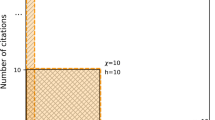Abstract
We introduce the dominance dimension principle and the parameterized family of criteria for the assessment of publication/citation profiles it generates. We show that by a suitable choice of parameters dominance dimension may specialize to the most widely known and used of those impact scores for the scientific output of authors which disallow endogenous reputation effects, including the Durfee- or h-number, the publication number and the citation number.
Similar content being viewed by others
References
Anderson, T. R., Hankin, R. K. S., & Killworth, P. D. (2008). Beyond the Durfee Square: Enhancing the h-index to score total publication output. Scientometrics, 76, 577–588.
Andrews, G. E., & Eriksson, K. (2004). Integer partitions. Cambridge, UK: Cambridge University Press.
Carayol, N., & Lahatte, A. (2009). Dominance relations and universities ranking. Cahiers du GREThA n0 2009-12, Université Montesquieu Bordeaux IV.
Egghe, L. (2006). Theory and practise of the g-index. Scientometrics, 69, 131–152.
Egghe, L. (2009). An econometric property of the g-index. Information Processing and Management, 45, 484–489.
Glänzel, W. (2006). On the h-index- a mathematical approach to a new measure of publication activity and citation impact. Scientometrics, 2, 315–321.
Hirsch, J. E. (2005). An index to quantify an individual’s scientific research output. Proceedings of the National Academy of Sciences of the United States of America, 102, 16569–16572.
Jin, B. (2007). The AR-index: Complementing the h-index. ISSI Newsletter, 3(1), 6.
Kosmulski, M. (2006). A new Hirsch-type index saves time and works equally well as the original h-index. ISSI Newsletter, 2(3), 4–6.
Marchant, T. (2008). An axiomatic characterization of the ranking based on the h-index and some other bibliometric rankings of authors. Scientometrics. doi:10.1007/s11192-008-2075-y.
Odifreddi, P. G. (1999). Classical recursion theory, Vol 1 (2nd ed.). Amsterdam: Elsevier.
Rousseau, R. (2008). Woeginger’s axiomatisation of the h-index and its relation to the g-index, the h(2)-index and the R2-index. Journal of Informetrics, 2, 335–340.
van Eck, N. J., & Waltman, L. (2008). Generalizing the h- and g-indices. Journal of Informetrics, 2, 263–271.
van Raan, A. F. J. (2006). Comparison of the Hirsch-index with standard bibliometric indicators and peer judgment for 147 chemistry research groups. Scientometrics, 67, 491–502.
Woeginger, G. J. (2008a). An axiomatic characterization of the Hirsch-index. Mathematical Social Sciences, 56, 224–232.
Woeginger, G. J. (2008b). A symmetry axiom for scientific impact indexes. Journal of Informetrics, 2, 298–303.
Woeginger, G. J. (2008c). An axiomatic analysis of Egghe’s g-index. Journal of Informetrics, 2, 364–368.
Zhang, C.-T. (2009). The e-index, complementing the h-index for excess citations. PLoS ONE 4(5), e5429. doi:10.1371/journal.pone.0005429.
Acknowledgments
Thanks are due to two anonymous referees for their most constructive criticisms and suggestions, as well as for providing me with valuable bibliographic references. In particular, one of the referees is to be credited for addressing me to the extant work on the h(2)-index and the g(2)-index.
Author information
Authors and Affiliations
Corresponding author
Rights and permissions
About this article
Cite this article
Vannucci, S. Dominance dimension: a common parametric formulation for integer-valued scientific impact indices. Scientometrics 84, 43–48 (2010). https://doi.org/10.1007/s11192-009-0091-1
Received:
Published:
Issue Date:
DOI: https://doi.org/10.1007/s11192-009-0091-1




